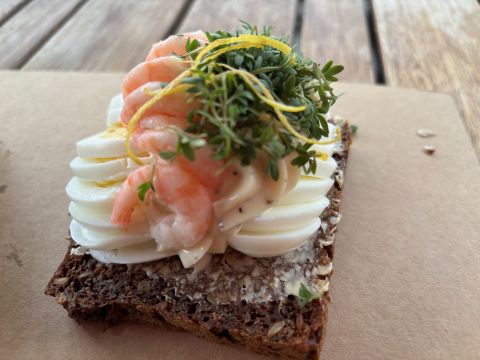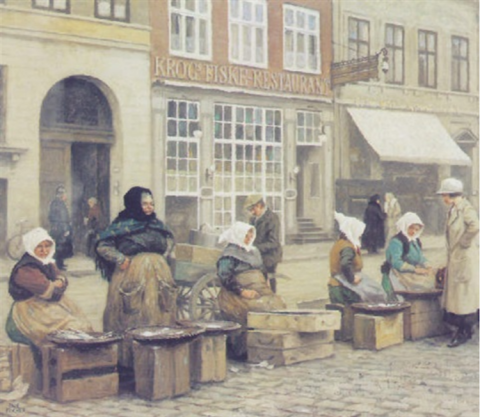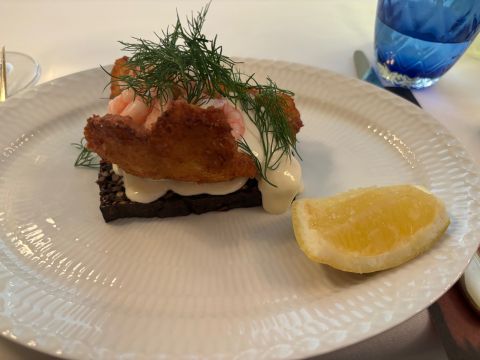We arrived in Copenhagen hungry and thirsty. Our host recommended Torvehallerne, an indoor collection of food and drink stalls in the centre of the city where I had been once before, and dropped us off there. It was a five-minute walk to our hotel, the highly recommended Kong Arthur.
We prowled around the market, marvelling at the number of wine bars, before the attractions of the open sandwiches at the popular Delikatesser stall proved too much. JR chose a roast beef sandwich while I bought my longtime favourite of sliced boiled eggs topped with peeled shrimps.
That proved the easy part. On this Friday afternoon the market was extremely busy even at 3.15 and a table was difficult to find. I led the way to a table outside but one protected from the rain and the wind by giant parasols.
Or so I thought. Within five minutes the heavens opened, the rain gushed down and the wind blew. Just as I imagine it did on 19 November 1965 when the Danish Food Centre first opened its doors on Cross Street in downtown Manchester.
I can still recall the shock of the food on offer then. Sandwiches with only one slice of bread! Peeled prawns! Lots of salads on display. My mother was in heaven and I can remember trips with her to the Danish Food Centre with the greatest of pleasure. What impelled this Danish invasion, I have no idea but the Food Centre prospered for 20 years before finally closing in 1985. I’m sure it wasn’t because they ran out of toppings; rather the reverse. The toppings on offer in Delikatesser looked distinctly similar to those that confronted us in Manchester. They are all excellent but perhaps this rather limited range is ripe for enlargement?
Perhaps that is the overall appeal of Copenhagen, a city I have visited a few times before but never really appreciated until this occasion when the mixture of the old and the new, often close by each other, really struck me. It’s a city full of surprises, of design stores and many impressive clothes stores, both new and vintage. ‘Next time we come here’, I suggested to JR, ‘it should be with empty suitcases.’
Happily, we always seem to travel with empty stomachs and my enquiries about a suitably old, long-established fish restaurant yielded a bullseye in the shape of Krogs Fiskerestaurant, initially opened by Christian Krogh in 1910 and still in the same location beside a canal, not unlike the scene shown at the top of this article.
In fact, the biggest difference between the scene in the painting of fisherwomen selling fish on the cobbles in front of the restaurant that graces their website and today is that the space is now filled with tables, chairs and customers enjoying the early afternoon sunshine. And on this particular day, the outside tables were occupied by happy customers.
Inside little seems to have changed in the past century. An antique Silver Cross pram was in the hallway, unoccupied. Inside, hanging proudly, was a portrait of King Christian X, bare-chested, complete with tattoos (he was a sailor, the waitress informed me). The room was lit by chandeliers and table lamps; the walls hung with paintings of sailing ships; and an old- fashioned drinks trolley crammed with bottles and glasses of all kinds was parked right in front of me.
It was the perfect location for a Saturday lunch, my favourite meal of the week. I had my book, soon a glass of Assyrtiko by my side, and a menu that was heavily fish-dominated. I began with the herring shown above, topped with elderflower on a slice of the Danes’ beloved dark rye bread. I followed this with a piece of fried ling topped with peeled shrimps and brown mayonnaise and enjoyed as a ‘main course’ a tartare of pike with a watercress emulsion and kohlrabi, shown below. By the time I paid my bill of 700 DKK, I had made good progress with my book while watching a table of Danish grandparents coo over their grandson. I left Krogs extremely happy, made even happier by a visit to a flea market 100 yards away.
What is now abundantly clear, with hindsight of course, is how clever it was of Rene Redzepi, the highly talented chef at Noma, and his insightful partner in the restaurant Claus Meyer, to lay down such universal and easy to follow principles for the renaissance of cooking in this region. Redzepi highlighted the attention that many chefs today pay to foraging, a then-forgotten aspect of cooking, and of reviving the idea of using past methods of preservation – fermentation, drying and storing – as the building blocks of today’s menus. But it was Meyer who set all this in geographical context with the publication of The Nordic Kitchen in 2016 and united the natural resources of Greenland, Iceland, Denmark, Sweden and Norway and the many fathoms of sea between these five countries.
This was brought home to me on our last night in Copenhagen when the attention of the six others round the table was focused instead on the improving quality of Danish wine. This range included sparkling and still wines from Hideaway, Kelleris and Skærsøgaard winery as well as a Pinot Noir and a port-style wine from Njord winery, among others, all of which are made in such tiny quantities that one can only hope the owners have alternative sources of income.
This dinner took place on the ninth floor of Axel Towers with fabulous 360-degree views of the city. The restaurant is called Trio because it’s spread over three floors although it is also one of three restaurants owned and carefully managed by Christian Aarø, whose other two restaurants are AOC and No.2.
The chef at Trio is the obviously experienced and thoughtful Damian Quintana, formerly number two at AOC restaurant. The menu he chose for us impressed us all, as did the thoughtful service, in particular with the delivery and removal of so many wine glasses.
But it was the sources of two dishes in particular which excited all of us round the table. The first was Trio’s signature dish, described afterwards in an email as ‘thin slices of Danish squid, poached in olive oil, served on fine polished sushi rice, with trout roe, finger lime and Icelandic wasabi with a sauce made with yuzu and katsuobushi and lots of butter.’ This was scrumptious, no other word can do it justice, the tiny pearls of squid and the rice melding together, the trout roe providing scrunch, and the whole given lift and lilt by the addition of the lime and wasabi, the origin of which raised a few eyebrows from the Danes round the table.
Then came a delicious dessert, a granita of plums and lavender sitting on top of a parfait of Norwegian brown cheese flavoured with cubeb pepper. The parfait was comforting, while the granita brought refreshment and the butterscotch notes of the cheese were muted.
This was an extremely well-thought-out conclusion to a meal that highlighted the vast potential available to chefs such as Quintana, however far he roams for his condiments. It is 1,500 km from Iceland to Norway, slightly further than the distance between London and Rome. It is a vast, rich and obviously exciting region, capable of inspiring many more Nordic chefs in the future.
TorvehallerneKBH Frederiksborggade 21, 1360 Copenhagen, Denmark
Krogs Gammel Strand 38, 1202 Copenhagen, Denmark; tel: +45 3315 8915
Trio Axel Towers, Jernbanegade 11, 1608 Copenhagen, Denmark; tel: +45 4422 7474
See also Eating out in Copenhagen from Nick’s visit in December 2023.
Image at top by Alexander Spatari via Getty Images. Interior image of set table at Krogs courtesy Krogs.
Every Sunday, Nick writes about restaurants. To stay abreast of his reviews, sign up for our weekly newsletter.






















